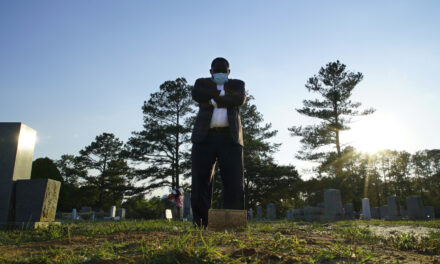
Assassination in Haiti: What We Know, and Don’t Know

The assassination has rocked the nation, stoking fear and confusion about what is to come.


During a nighttime attack on July 7, a group of assassins fatally shot President Jovenel Moïse of Haiti and wounded his wife, Martine Moïse, in their private residence on the outskirts of the capital, Port-au-Prince. The assassination rocked the nation, stoking fear and confusion among residents and the Haitian diaspora about what is to come.
Some details of the attack are coming into focus, but there are many that we don’t know.
What we know about the attack.
Image
The assassins charged into Mr. Moïse’s residence sometime after 1 a.m. in what officials described as a well-planned operation that included “foreigners” who spoke Spanish.
Mr. Moïse had counted on a high level of protection, usually traveling with more than a dozen armored cars and police guards. There are often 100 officers from the presidential guard around the president’s home, former Prime Minister Laurent Lamothe said.
Yet there had been no specific warning of Wednesday’s attack, said Haiti’s ambassador to the United States, Bocchit Edmond.
Carl Henry Destin, a Haitian justice of the peace, said the president’s home had been peppered with holes and littered with bullet casings, and he had found the body of the president lying on the floor at the foot of his bed, “bathed in blood.”
“There were 12 holes visible in the body of the president that I could see,” he told The New York Times. “He was riddled with bullets.”
The president’s house had also been ransacked, said Mr. Destin. “Drawers were pulled out, papers were all over the ground, bags were open,” he said. Two servants had been tied up, he said.
Ms. Moïse was injured in the attack and was flown to the Ryder Trauma Center in Miami. She was in stable condition, according to the ambassador, Mr. Edmond.
The attackers’ precise motive is not yet clear.
What we know about the suspects.
Image
Two Americans are among the at least 20 people who have been detained thus far, Haitian officials said on Friday, adding to their assertions that “foreigners” had been involved in the brazen assault. The ambassador, Mr. Edmond, described the assailants as “well-trained professionals, killers, commandos.”
At a news conference at National Police Headquarters with the interim prime minister, the American men were identified as Joseph Vincent, 55, and James J. Solages, 35, Florida residents of Haitian descent. Another 18 detained suspects were described as Colombians.
Clément Noël, a judge who is involved with the investigation, said on Friday that Mr. Vincent and Mr. Solages claimed that they were not in the room when Mr. Moïse was killed and that they had worked only as translators for the attackers.
The judge said the two met with other members of the hit squad at a hotel in a suburb of Port-au-Prince to plan the attack, which they said was plotted out over a month. The men, according to the judge, said the goal was not to kill the president but to bring him to the national palace.
It’s still unknown what evidence the Haitian authorities have against the two men, when they had entered the country and what their connection might be to those in the hit squad identified as Colombian.
At least six more suspects were on the run, authorities said. Security forces made the first arrests after engaging in a chaotic shootout late Wednesday.
Judge Noël said that it was Mr. Solages who had yelled that the assailants were agents of the U.S. Drug Enforcement Agency at the start of the assault. Both U.S. and Haitian officials have said the attackers were not associated with the D.E.A.
Mr. Solages had previously worked as a security guard at the Canadian Embassy in Haiti.
Who is in charge? A power struggle stirs further uncertainty.
Image
A power struggle between two competing prime ministers has further fueled tensions in the turbulent Caribbean nation of 11 million people, one of the poorest in the world.
In the hours after the killing, the country’s interim prime minister, Claude Joseph, said he was in charge, taking command of the police and army. He declared a “state of siege” for 15 days, essentially putting the country under martial law. It was not clear whether he has the legal authority to do so.
Beyond that, questions emerged over whether Mr. Joseph is, in fact, the rightful prime minister.
Just days before his death, Mr. Moïse had appointed a new prime minister, Ariel Henry, who was expected to be sworn in this week. Mr. Henry has said he should be in charge of the government.
Adding to its troubles, Haiti, a parliamentary democracy, has no functioning Parliament. There are currently only 10 sitting senators out of 30; the terms of the other 20 have expired. The entire lower house is no longer sitting, because the representatives’ terms expired last year. The head of the nation’s highest court, who might have helped bring order, died of Covid-19.
Haiti says it requested U.S. troops.
Haitian government officials said they had asked that the United States provide troops to help protect the country’s key infrastructures as the nation faces unrest from the assassination.
The Haitian minister of elections, Mathias Pierre, said the request was made because President Biden and Secretary of State Antony Blinken had promised to help Haiti.
In news briefing on Friday, a deputy State Department spokeswoman, Jalina Porter, said she could not confirm such a request.
But The White House press secretary, Jen Psaki, did say that the United States would be supporting the country by dispatching senior F.B.I. and homeland security officials to Port-au-Prince “as soon as possible.”
Source: https://www.nytimes.com/2021/07/08/world/americas/haiti-president-killed.html
















